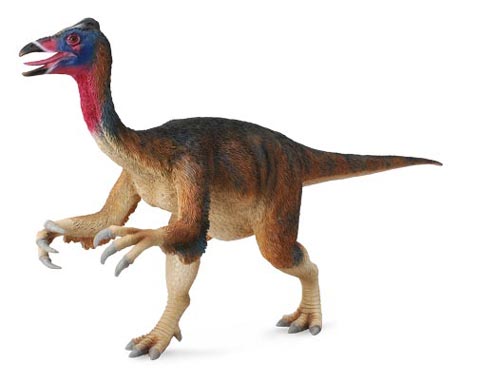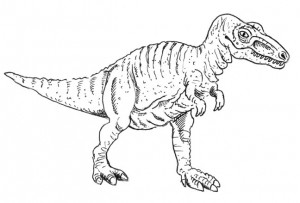A Helping Hand for Deinocheirus
Fifty Year Dinosaur Mystery Finally Solved
As the dust settles after the annual Society of Vertebrate Palaeontology meeting, time to reflect on the huge amount of new information on the Dinosauria that the Los Angeles gathering presented. Time also to re-write our notes and update the fact sheet on that most enigmatic member of the Dinosauria – Deinocheirus. Thanks to an international team of scientists, including Professor Phil Currie (University of Alberta), the quarry, where the original fossils of this bizarre dinosaur were found, has been re-explored and we now know a lot more about Deinocheirus mirificus “Peculiar Terrible Hands”.
Deinocheirus
Members of the Korea-Mongolia International Dinosaur Project re-opened the quarry site where the original holotpye material, those huge forelimbs, had been discovered by a joint Polish/Mongolian expedition back in the summer of 1965. In addition, partial skeletons of two other specimens were located close by to where the original fossil material had been found, The fragments of fossil bone plus remains of gastralia (belly ribs) collected from the first quarry in conjunction with the fossils excavated from the two new sites has enabled scientists to piece together what Deinocheirus actually looked at – fans of bizarre-looking dinosaurs won’t be disappointed.
A Model of Deinocheirus based on the Holotype Material
Picture credit: Everything Dinosaur
Since the first fossils were discovered and the naming of Deinocheirus back in 1970, there have been numerous theories put forward as to what this dinosaur’s bones actually represented. This is a great excuse to get out all our old files related to “Terrible Hands”, to thumb through long forgotten text books and various dinosaur encyclopaedia looking back at some of the ideas that have been proposed. The 1965 expedition recovered both forelimbs with the exception of the claws of the three-fingered right hand, the complete shoulder-girdle plus fragments of ribs, gastralia, and elements from the backbone.
The Nemegt Formation
The Nemegt Formation of Mongolia had never yielded a set of strange fossil bones such as this, although reports of such fossil finds from this area had been circulating for some time.
Over the next few years, the leader of the expedition, the remarkable Professor Zofia Kielan-Jaworowska, the first woman to be appointed to the executive committee of the International Union of Geological Sciences, had her photograph taken on numerous occasions standing next to the Deinocheirus holotype exhibit. The Professor now in her late eighties, would pose next to forelimbs providing a scale for the colossal arm bones. We wonder what she makes of the Deinocheirus developments.
A Photograph of Professor Kielan-Jaworowska and the Deinocheirus Forelimbs
Deinocheirus mirificus
Many of the researchers involved in the initial study of the fossil material thought that Deinocheirus was an enormous predator. The arms being many times the size of the largest meat-eating dinosaur known from the Nemegt Formation (Tarbosaurus bataar). This interpretation soon fell out of favour, but Tarbosaurus was destined to play a role later on in the Deinocheirus story. The idea that these were the arms and claws of a carnivore began to lose support, the claws, although over twenty-five centimetres long were not as curved as seen in large allosaurids, or in the Tyrannosauridae. Perhaps, these were the claws of an enormous bipedal herbivore. Other theories put forward over the years included ideas about Deinocheirus being a member of the segnosaurs (therizinosaurs), after all, the fossils of a gigantic therizinosaur (T. cheloniformis) had been found in Mongolia.
Then there was the hypothesis that the limb bones of this dinosaur were roughly equal sized and that these were the forelimbs of an arboreal dinosaur, one that climbed trees, perhaps the Dinosaurian equivalent of a great ape. More recently, the suggestion that the fossils represented some super-sized member of the ornithomimids began to hold sway. The holotype fossil material was similar to that seen in the fast-running ornithomimid group, although they would represent an animal at least twice the size of the largest known member of the Ornithomimosauria.
Strange Hands and Claws
At the time, the 1965 expedition team thought that much of the skeleton of the first specimen had been eroded away. However, an extensive re-examination of the original dig site yielded a lot more fragmentary material, even some skeletal elements were recovered from the spoil heaps of the 1965 excavations. These fossils provided clues as to what might have happened to the remainder of the carcase. Tell-tale bite marks on some of the fossil bones indicate that a tyrannosaur, most likely a large Tarbosaurus bataar and dined on this dinosaur, it seems that the Polish/Mongolian scientists had been lucky to find the fossilised bones of the bits the tyrannosaur did not fancy. Although the researchers cannot be certain, the bite marks indicate that they were made post-mortem. The grooves and scratches recorded in the fossil bones were most likely made by a Tarbosaurus that scavenged the carcase of an already dead Deinocheirus.
A Drawing of the Likely Deinocheirus Eater – T. bataar
Picture credit: Everything Dinosaur
New Fossil Discoveries
The two new specimens of Deinocheirus were discovered in 2006 and 2009 respectively. One of the specimens represents a sub-adult, (the 2006 discovery), the second specimen are the remains of an individual that was probably bigger than the holotype. The larger dinosaur’s fossils were found at Bugin Tsav, the upper arm bone is nearly six centimetres longer than the humerus of the original specimen. Those claims of Deinocheirus being up to twelve metres in length are not too far fetched after all.
This new material when examined alongside the Deinocheirus fossils discovered in the mid 1960s has allowed scientists to piece together a picture of this Late Cretaceous dinosaur. Over 1100 small stones (gastroliths) were recovered from the body cavity of the Bugin Tsav Deinocheirus. These stones, some of which are over 8 centimetres long indicate that Deinocheirus was indeed a herbivore. Lacking teeth like most of the ornithomimids, these stones very probably helped to grind up and digest tough plant fibres. Deinocheirus was also very tall, it was one of the tallest members of the Theropoda known with the largest specimen, indicating a head height of around sixteen feet, that’s tall enough to look over your average British lamp post!
A Slow Dinosaur
The heavy duty pelvis and the sturdy hind limbs make Deinocheirus the “plodder” when it comes to the Ornithomimosauria, it was not an exceptionally fast runner. However, with its strong arms and sheer size it would have made a formidable opponent should any predator attempt to tackle it. When compared to large therizinosaurs, the ribs of Deinocheirus suggest that it was somewhat more narrow bodied. Perhaps it had less of a pot belly when compared to T. cheloniformis for example.
The most intriguing finding from this new study of the available Deinocheirus material is that this dinosaur had a hump! Tall neural spines on the vertebrae associated with the hip area very probably supported a fleshy hump or possibly a sail-like structure. Everything Dinosaur team members are not aware of any such structures being reported when it comes to other ornithomimids. However, tall neural spines are known from other members of the Dinosauria, most notably Ouranosaurus and the spinosaurids. The purpose of this hump or sail in the likes of Deinocheirus remains open to speculation, but team members have raised the possibility that this was a fat reserve store for this herbivore, a similar structure to that found in extant camels today.
Everything Dinosaur’s Amended Drawing of Deinocheirus (D. mirificus)
Picture credit: Everything Dinosaur
With this new evidence in mind, we are going to have to amend the fact sheet that we produce on Deinocheirus. Palaeontology is a science that is constantly revising and re-visiting known data so our fact sheets are reviewed frequently and updated.
To view models and replicas of Deinocheirus and other dinosaurs: PNSO Age of Dinosaurs Figures and Models.
Humps and bumps on dinosaurs are not new, however, this is an exciting development for a member of the Coelurosauria of which the Ornithomimosauria form but a small part. We have had to amend our scale drawing of Deinocheirus giving it a pronounced hump over its pelvic area. Our interpretation may be a little conservative when compared to others, but for now it is reward enough for us to know that a fifty-year-old puzzle has been solved.





